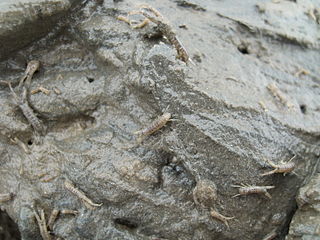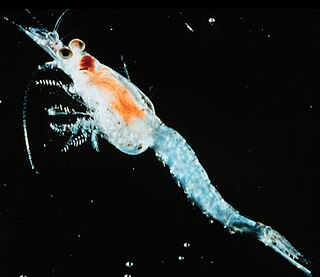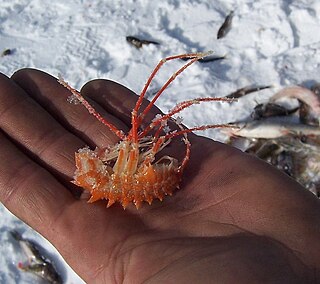Related Research Articles

Corophiidae is a family of amphipods, containing the following genera:

Calliopiidae is a family of amphipods, containing the following genera:

Liljeborgiidae is a family of amphipods, containing the following genera:

Oedicerotidae is a family of amphipods. It comprises the following genera:

Lysianassidae is a family of marine amphipods, containing the following genera:

Corophium is a genus of the amphipod family Corophiidae. Formerly a much larger genus, many species have been transferred to segregate genera such as Monocorophium and Crassicorophium.

Gammaridae is a family of amphipods. In North America they are included among the folk taxonomic category of "scuds", and otherwise gammarids is usually used as a common name.

Mysis is a genus of mysid crustaceans in the family Mysidae, distributed mainly in the coastal zone of the Arctic and high boreal seas. Several species also inhabit northern freshwater lakes and the brackish Caspian Sea. Fifteen species are recognized. Body lengths range from 1 to 3 centimetres.
Paradiaptomus is a genus of crustacean in the family Diaptomidae. It includes the following species:

Nannastacidae is a family of crustaceans belonging to the order Cumacea. They have no free telson. The endopods of the uropods are present on one segment. There are exopods on the maxillipeds and generally one on pereopods 1–4 in males and 1–2 in females. In the females the second antenna is much shorter than the first. It contains the following genera:

Idotea is a genus of isopod crustaceans, mostly from cold temperate waters. The taxonomy of the genus is still in doubt, and many of the currently recognised species may be taxonomic synonyms, and others may be moved to different genera.

Paramysis is a genus of mysid crustaceans (Mysidacea) in family Mysidae, distributed in coastal zone of low boreal East Atlantic Ocean, Mediterranean Sea and the basins of Black Sea, Sea of Azov and Caspian Sea.

Acanthogammaridae is a family of amphipod crustaceans, endemic to Lake Baikal. It contains the following subfamilies and genera:
Pallaseidae is a family of amphipod crustaceans endemic to Lake Baikal. Some species are also found in the Angara River which flows out of Lake Baikal, and one species is distributed throughout Northern Palearctic. The composition of the family is a subject of discussion, with different sources listing either 9 genera and 58 species, or 8 genera and 20 species. They are benthic, nectobenthic or epibiotic.

Bela is a genus of sea snails; marine gastropod mollusks in the family Mangeliidae.
Babr is a genus of amphipod crustaceans in the family Pallaseidae, endemic to Lake Baikal. There are 2 species in the genus.

Amphilochidae is a family of amphipod crustaceans, containing the following genera:
Chelicorophium curvispinum is a species of amphipod crustacean. It lives in salt, brackish and fresh water, and may reach 6 millimetres (0.24 in) in length. It occurs in the Caspian Sea, the Black Sea and adjoining rivers, and in river systems emptying into the southern Baltic and North Sea.
Gmelina is a genus of crustaceans of the family Gammaridae, containing two species:

Gammaroidea is a superfamily of crustaceans in the order Amphipoda.
References
- ↑ Jim Lowry (2011). Lowry J (ed.). "Chelicorophium Bousfield & Hoover, 1997". World Amphipoda database. World Register of Marine Species . Retrieved November 27, 2011.